Precision Meets Efficiency: Automating Total Fat Testing in the Lab
When it comes to food analysis, fat content holds a pivotal role, sharing the stage with crucial parameters like moisture, protein, fiber, and sodium. While often associated with dietary caution, fat is far more than just a nutritional component. It plays a pivotal role in food quality assessment, energy content determination, and even product market value.
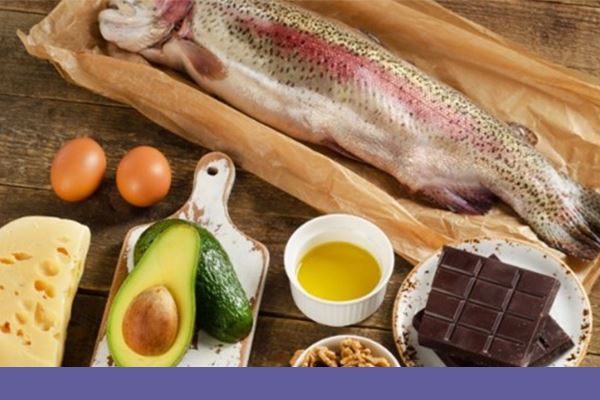
Why Analyze Fat Content?
Regulatory Compliance: Food labeling regulations often mandate accurate fat content information on product labels. Complying with these regulations is vital for food manufacturers to avoid legal issues and maintain consumer trust.
Quality Assessment: The fat content can significantly influence the taste, texture, and overall quality of food products. For instance, in meat, fat affects juiciness and flavor, while in baked goods, it influences texture and moisture content. Maintaining consistency in taste is crucial for manufacturers because any deviation from the original recipe can negatively impact the product's market acceptance.
Nutritional Information: Fat is a macronutrient that our bodies need for various functions. Understanding the fat content in food products helps consumers make informed dietary choices. Moreover, different types of fats have distinct effects on health, so knowing the fat composition is essential for a balanced diet.
Energy Content: Fat is a calorie-dense nutrient. Determining the fat content in food is essential for estimating the energy value of the food, which is crucial for meal planning and dietary management.
Animal Nutrition: In the context of animal feed, the fat content is vital for determining the feed's nutritional value. Different animals have varying dietary fat requirements, and knowing the fat content is crucial for their health and productivity.
Source Identification: Fat can originate from various sources, such as vegetable oils, animal fats, recycled fats, and more.
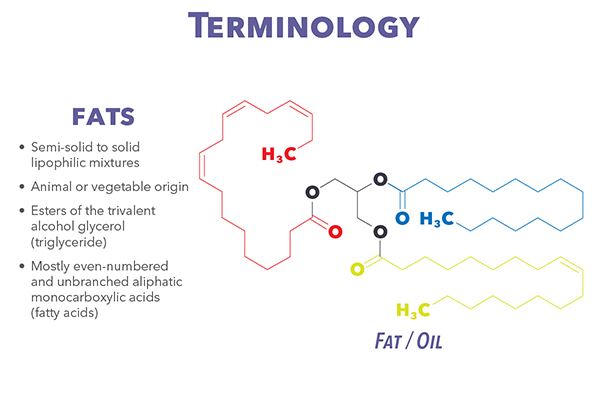
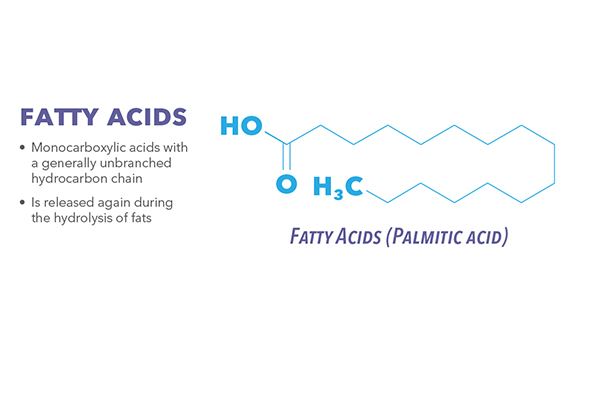
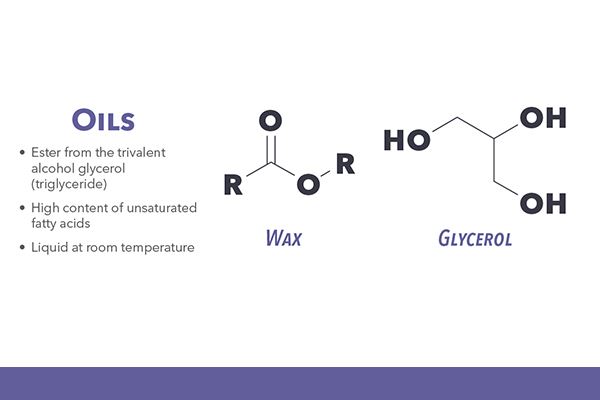
Methods for Analyzing Fat Content
Several methods are available for analyzing fat content, each with its unique advantages and limitations.
Gravimetric Reference Methods
Weibull-Stoldt Method/ Weibull-Berntrop: This gravimetric reference method involves hydrochloric acid digestion followed by a thorough solid-liquid extraction. This method is highly regarded for its precision and reliability, as well as its versatility making it universally applicable, and that's why we emphasize its significance with the HYDROTHERM-SOXTHERM systems.
Mojonnier Method: Similar to the Rose-Gottlieb method, it's commonly used in fat analysis it is very manual and less precise than the Weibull-Stodlt method. It also relies on diethyl ether, which comes with drawbacks including flammability and potential health hazards.
Rose-Gottlieb/Babcock Method: Often used in the milk industry, this method uses basic digestion with a different solvent system than Weibull-Stoldt with a liquid-liquid extraction.
Schmid-Bondzynski-Ratzlaff Method: Similar to the Weibull-Stoldt method, but much less common, it employs hydrochloric acid digestion and liquid-liquid extraction.
Volumetric Quick Methods
Gerber Method: This chemical quick method employs a butyrometer for rapid fat analysis designed for fat in dairy products, specifically milk. It is less versatile when dealing with changing sample matrices such as oils, meats or processed foods.
Secondary Methods
NIR and NMR Methods: These non-destructive methods provide quick results but require calibration against reference methods like the Weibull-Stoldt method to ensure accuracy and are therefore considered secondary methods.
The Challenge of Fat Analysis
Before we dive into hydrolysis, it's essential to understand why it's necessary. Simply put, without hydrolyzing your sample, you won't have access to all the fat it contains. Fat molecules in both animal and plant cells tend to form micelle structures due to their hydrophilic heads and hydrophobic tails. Breaking down this structure is the key challenge in total fat analysis. By doing so, you can extract fats that are chemically and physically bonded within the sample.
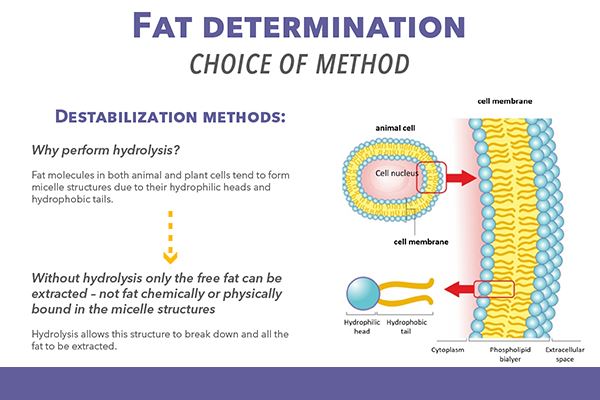
Let's consider an example involving processed samples or mixtures of different products, such as infant food containing 5% of starch or dextrin or vegetables, fruits, meat, etc., Weibell-Stodlt was the clear winner in this “Goldilocks” method story. The Rose-Gottlieb offered too low of results, while Schmid-Bondzynski-Ratzlaff yielded too high of results. The Weibull-Stoldt method shines as a robust and universally applicable choice.
Different Types of Fat Determinations
Before delving into the fat determination process, it's important to clarify the different types of fat determinations:
Total Fat Determination: This involves hydrolysis and subsequent extraction to access all fat, including that bonded within micelles.
Free Fat Determination: Used for quick assessments, this method involves only an extraction, excluding bonded fats.
Crude Fat A and B: Rarely used, these methods are reserved for samples containing small fatty acids with low molecular weight. They require extraction before hydrolysis to avoid losing water-soluble fats. They are much less accurate for comprehensive fat determination.
Sample Preparation for Other Determinations: The SOXTHERM extraction can also serve as sample preparation for fat spectrum analysis, peroxide value or environmental studies like dioxin and pesticide analytics.
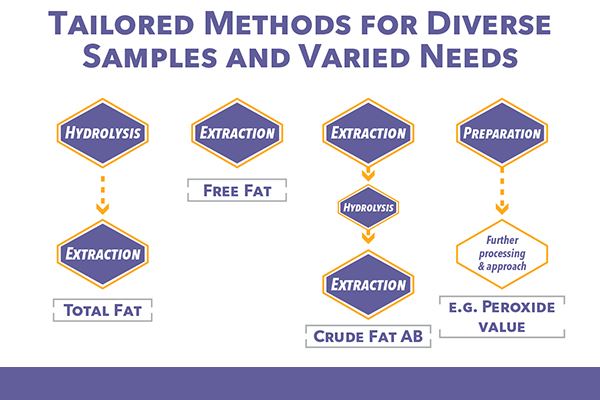
The difference between total fat analysis and free fat analysis varies depending on the sample type. For example, while hydrolyzing egg powder may yield 42% fat content, a free fat determination may only show 36%. The difference can be even more significant in other samples, such as instant yeast, where the result can nearly double with hydrolysis. In general, hydrolysis typically reveals a higher fat content than free fat analysis.
The Fat Determination Process
Sample Preparation
Now, let's delve into the actual fat determination process, starting with the critical step of sample preparation. The approach to sample preparation depends largely on the sample type. The goal is to create a homogeneous sample from which you can extract a representative amount for fat analysis. Here are some considerations for different sample types:
Milk: Even though milk may appear homogeneous, it requires heating in a water bath for 20-30 minutes with stirring to ensure homogeneity.
Solid Samples: For solids like corn, mixing or grinding is necessary.
Challenging Samples: In the case of products like chocolate bars, where heat can alter the composition, cryogrinding might be necessary to maintain accuracy.
Mistakes in sample preparation can significantly impact the final results, underscoring the importance of this initial step in the fat determination process.
Hydrolysis Step
Manual
Hydrolysis is a crucial step in fat analysis, and HYDROTHERM is at the forefront of automating and streamlining this process.
Manual Hydrolysis: A Time-Consuming Process
To understand the intricacies of manual hydrolysis, picture a traditional heating bench with four positions for samples prepared with hydrochloric acid. The process involves:
Heating: Samples are heated for about 60 minutes in hydrochloric acid for digestion.
Filtration Preparation: Setting up the filtration process, which can be cumbersome and space-consuming.
Filter Paper Moisturizing: Moisturizing filter papers to prevent the loss of fats that aren't water-soluble.
Rinsing and Diluting: Repeatedly rinsing beakers with hot water to transfer all fats to the filter papers and ensure they are acid-free.
Checking pH: Verifying that the filter paper is pH-neutral.
Drying: Placing the filter paper in a drying oven for further analysis.
This manual process can be time-consuming and requires significant laboratory space, particularly within a fume hood. Additionally, like many manual procedures, the level of variability can be quite high when different technicians are involved.
HYDROTHERM: A Game-Changer for Hydrolysis
The HYDROTHERM instrument revolutionizes the hydrolysis step by automating the process, saving time and resources and operates in complete accordance with the Weibull-Stoldt Method.
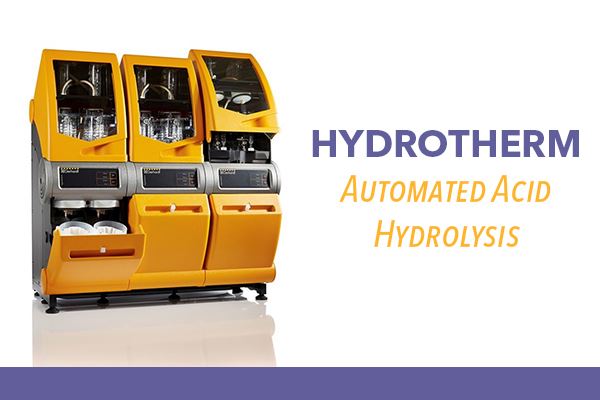
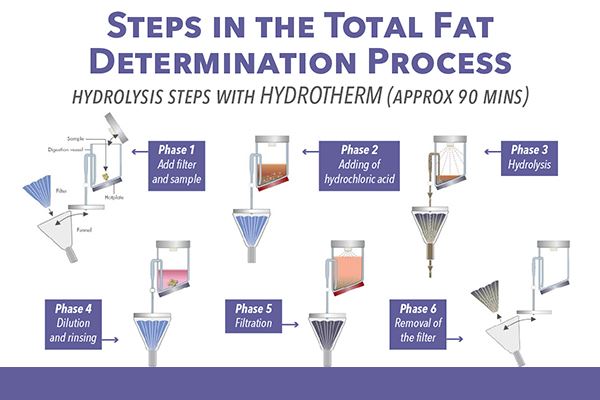
Automated Steps: The HYDROTHERM performs most steps automatically, including adding hydrochloric acid, heating, rinsing, and transferring hydrolyzed fats to filter papers.
Reduced User Interaction Time: Unlike the manual process, which consumes substantial operator time, the HYDROTHERM operates with minimal reliance on laboratory staff. It effectively manages critical parameters, including heating power and water temperature.
Filtration Efficiency: The HYDROTHERM's filtration process is fast and efficient, with a fail-safe sensor to ensure accuracy.
Cost and Time Savings: The time savings with the HYDROTHERM are substantial. In the manual process, you may need up to 8 minutes of hands-on involvement per sample. In contrast, the HYDROTHERM streamlines the process to approximately 1.5 minutes per sample, freeing up laboratory staff to focus on more complex tasks. Furthermore, the HYDROTHERM can simultaneously hydrolyze 6 samples, enhancing efficiency.
Space-Saving Design: The HYDROTHERM eliminates the need for a water boiler and vacuum source, freeing up valuable laboratory space and reducing equipment costs.
Error Reduction: By entrusting tasks to automated systems, you create a robust foundation for consistently reliable outcomes, reducing the likelihood of human-induced errors and enhancing overall data precision. With a reduced error rate, you can ensure higher levels of precision and result accuracy.
Sample Flexibility: Unlike traditional methods, HYDROTHERM allows for working with high sample amounts, up to 20 grams or 50 milliliters. This flexibility is especially useful for samples with low-fat content or those that are inherently inhomogeneous.
Efficient Extraction: SOXTHERM
Following hydrolysis, the next step in total fat analysis is extraction. SOXTHERM takes the lead in this phase, offering efficiency and a huge time savings.
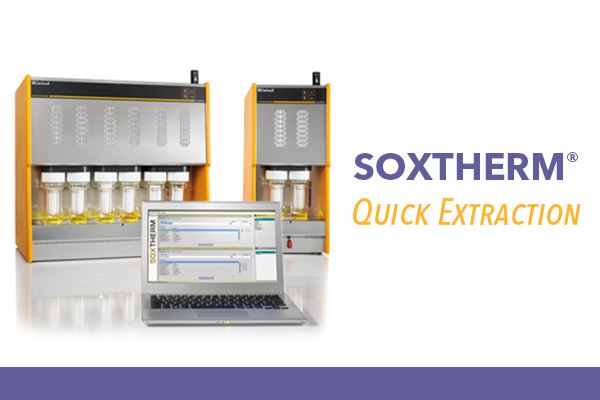
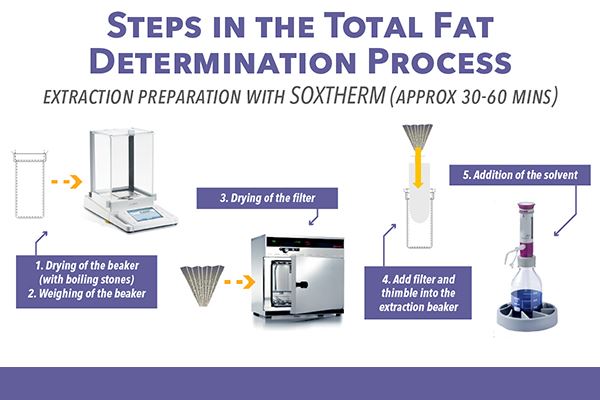
The SOXTHERM process
The Heat-Up Phase
The process begins with the beaker, along with the sample, being lowered onto the heating plate. During the subsequent heat-up phase, the sample and heating plate reach the desired temperature as specified in the method. Meanwhile, the solvent starts to boil, and its fumes are directed to the condenser.
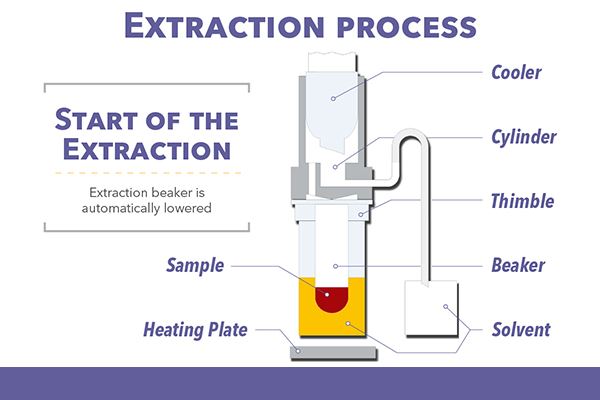
The Crucial First Extraction Phase
Once the system reaches the preset temperature, the countdown begins for the first extraction phase, known as the hot extraction phase. Here, the sample is immersed directly in the hot solvent, enabling rapid extraction. In this phase, a substantial portion of the fat content is extracted. However, there's a catch – due to the direct immersion, equilibrium is reached quickly, and not all fat can be extracted. Around 95% can be extracted, but the remaining 5% remains in the sample.
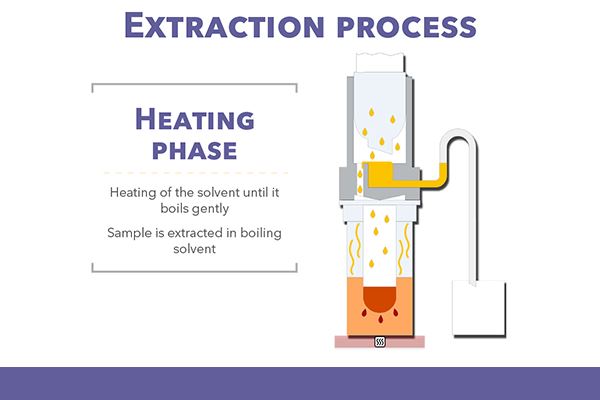
Unlocking the Last 5% with Evaporation A
To recover that last 5%, the process moves on to the Evaporation A phase. In this stage, the PTFE cylinder is emptied with uncompressed air, flushing the solvent back into the solvent tank, recovering approximately 50 milliliters. This step is repeated several times to achieve the desired solvent-to-sample separation, breaking the equilibrium state.
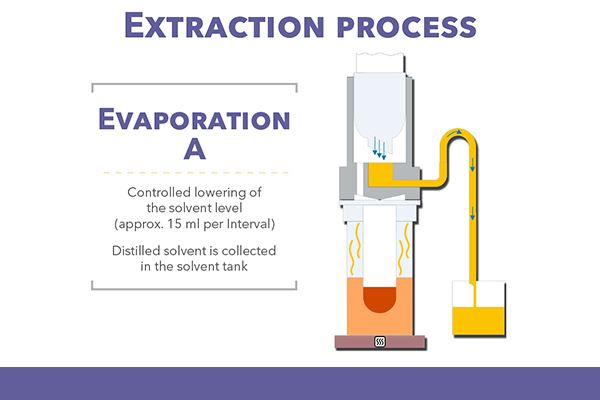
Twisselmann Extraction Phase: Unleashing Full Extraction
With the solvent separated from the sample, the process enters the Twisselmann extraction phase, which typically lasts an hour. During this phase, the sample is exposed to the hot fumes of the solvent, and the PTFE cylinder again fills and empties. This time, extraction occurs within the hot fumes and recondensed solvent, allowing for the complete extraction of all fat within the sample.
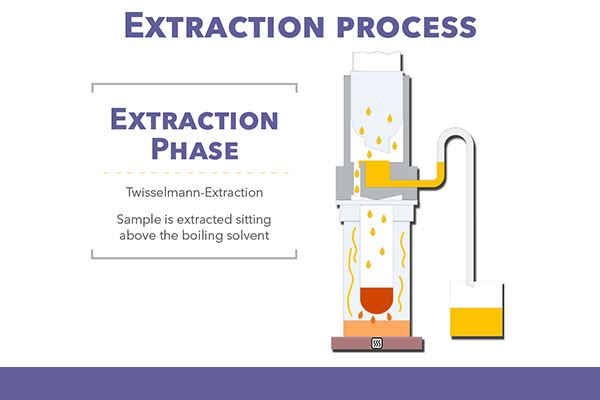
Wrapping Up with Evaporation
As the second extraction phase concludes, there's often some residual solvent left in the beaker. This is where the Evaporation phase comes into play once more. Using compressed air, the remaining solvent in the PTFE cylinder is flushed back into the solvent tank. At this point, the process is nearly finished.
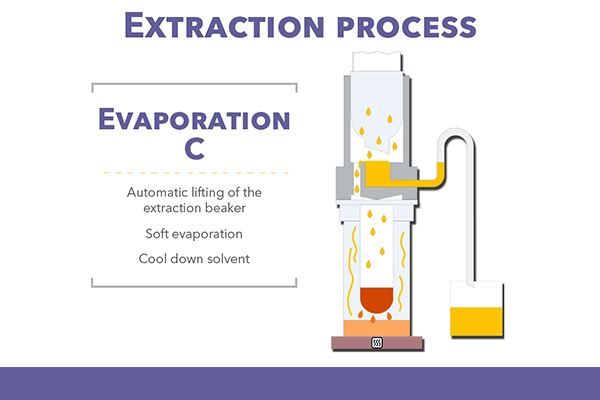
Conclusion: Speedy and Precise Fat Analysis
With the extraction steps complete, the sample, now containing isolated fat and some solvents, can be transferred to a drying process. Traditional Soxhlet extraction can take anywhere from 8 to 10 hours. In contrast, SOXTHERM offers a rapid alternative, providing results in as little as two hours from start to finish.
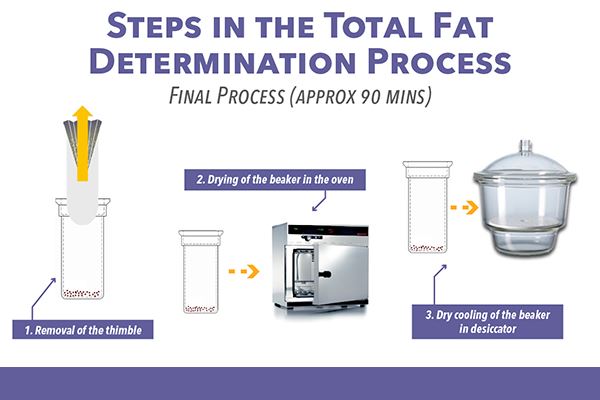
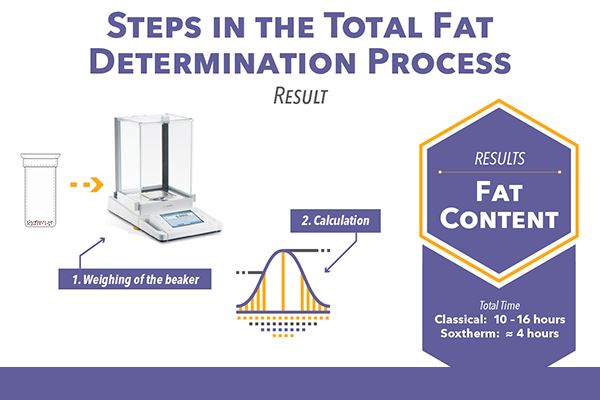
Now that you have saved time, the SOXTHERM has additional features to highlight:
User-Friendly Operation
SOXTHERM is designed with simplicity in mind. The instrument is equipped with a user-friendly interface. A safety shield, activated with a quick start button, enhances the ease of operation. But what truly sets SOXTHERM apart is its ability to save and recall programs. If you frequently use the same program, there's no need to fuss with control units or software—simply press "Run" to start the process and "Stop" to halt it.
Customization at Your Fingertips
Flexibility is another hallmark of the SOXTHERM instrument. Users have the power to customize various parameters, including timing, temperature, and more, to tailor the extraction process to their specific needs. This level of control ensures that the instrument can adapt to a wide range of applications and sample types.
Two Control Options
SOXTHERM offers two convenient methods for controlling the unit. The first is the "SOXTHERM Manager," a PC software that provides a comprehensive interface for program setup and monitoring. Alternatively, for labs that prefer not to have a computer in the workspace, the "MULTISTAT" external control unit offers a seamless experience.
Solvent Recycling: A Sustainable Approach
Environmental responsibility is a growing concern in the laboratory setting. SOXTHERM addresses this by incorporating solvent recycling into its design. The instrument includes a solvent tank with a release valve at the front, allowing for the efficient recycling of solvents. Compared to traditional Soxhlet extraction methods, this not only reduces waste but also lowers solvent consumption. While a Soxhlet extractor typically requires 400-500 milliliters of solvent, SOXTHERM's design significantly reduces this demand by 30% to 150ml.
Cutting-Edge Safety Features
Safety is paramount when working with organic solvents. SOXTHERM incorporates several cutting-edge safety features to mitigate risks. One such feature is the redundant safety plug, designed to prevent ignition by adhering to the Temperature classification of different solvents; the minimum temperature at which a substance's vapors will ignite if exposed to an open flame, spark, or other ignition source. Moreover, most of the system operates under low voltage, except for the heating element which are housed to ensure fumes cannot be ignited, even in the event of a spark.
Expandable and Adaptable
SOXTHERM's versatility extends to its scalability. Laboratories can choose from various configurations, including the six-place, four-place, and two-place versions. Furthermore, these instruments can be combined and controlled by a single unit. This flexibility allows labs to adapt to changing sample throughputs without the need for an entirely new setup. Start small and upgrade seamlessly as your needs evolve.
HYDROTHERM and SOXTHERM are reshaping the landscape of total fat analysis in laboratories. By automating and optimizing critical steps like hydrolysis and extraction, these instruments enhance accuracy, precision, speed, safety, sustainability, and cost-effectiveness. Whether you're dealing with high sample volumes or inhomogeneous samples or simply aiming to improve laboratory efficiency, HYDROTHERM and SOXTHERM are your dynamic allies, revolutionizing the future of fat analysis.
>>> Watch an on-demand webinar: Automate Your Total Fat Analysis
